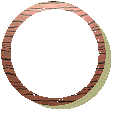- The student asked, "Buddhism arose in the Hindu astheticism in India; moved to China where, under the influence of the Taoism, it became Zen; then found its way to Japan, transformed further by Shinto. Is it not irreverent to use something that carries the wisdom of centuries to talk about Internet web pages?"
- The master replied, "I've a mind to repeat Joshu's Mu! and send you on your way. Have you been listening? The idea of 'irreverant' has no place here. Zen is only irreverent. When Tosan was asked 'Who is the Buddah?', did he not reply 'Three chin of flax'? When Joshu came to study under Nansen and asked 'What is the true Tao?', wasn't he told, 'Your everyday mind, that is the Tao'? How is a web page different from the ricepaper of the Japanese masters who spent years meditating on the simple brush strokes of their painted characters?"
- The following day, the student returned, asking, "JavaScript is only one tool among many used in web programming. Isn't focusing on this one thing like that Zen story about the man describing the moon being told he was confusing his finger with the moon?"
- The master smiled. "You've learned more than I thought. Of course it's like that. In the beauty of the garden, we don't think of the trowel. But remember the saying 'You can't learn it through books. You can't learn it without books."
- The student argued, "But we've already got lots of books, and web pages. There's plenty of advice. Use small graphics. Include their dimensions in the code. Reduce them to their minimum color bitsize. Load the page quickly. Don't use blinking text, dancing bears. Don't say 'Click Here'. 'Think' before you 'ink'. What can Zen really add?
- The master responded, "Those aren't bad ideas - just very 'western'. They're about parts. Zen is about the whole thing. They don't capture, for example, the spirit of the tea, the haiku, the sumi-e sketches. They avoid the 'quiet suchness of things happening by themselves'. They miss the principles of asymmetry, imbalance, the 'one corner' style, the 'thrifty brush', the lonliness of wabi, the surprise of a child creating [sono-mama]."
- Again, the student argued, "But what of the eighth oxherder picture - or Eno's poem? They're about nothingness! Zen teaches emptiness. How can we then talk about what's in an Internet web page?"
- The master asked, "What else is there?" ... and vanished.
|

